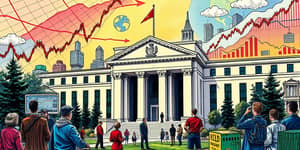
Inflation is not just a number reported by economists—it directly touches every investor’s portfolio. As prices climb, the relative value of cash shifts, bond yields move, and equities react to changing expectations. In mid-2025, markets face new challenges: soaring tariffs, shifting labor dynamics, and renewed volatility. Understanding these forces is essential for adapting your investment approach and preserving long-term growth.
By mid-2025, policy uncertainties and cooling labor market trends have kept the Federal Reserve and investors on edge. The sudden imposition of tariffs, pushing the average effective rate above 15%—a level unseen since the 1930s—triggered a swift 20% drop in the S&P 500.
Yet, when trade talks revived and tariffs paused, U.S. equities rebounded fully by May. International stocks, less tethered to domestic policy shifts, outpaced their U.S. counterparts, while many analysts now predict one or two Fed rate cuts in the latter half of 2025. Staying informed on these developments remains critical.
Inflation operates through multiple channels, reshaping returns and risk across asset types. Investors must recognize which holdings suffer and which may benefit as price levels rise.
Within equities, value stocks tend to outperform growth shares during heightened inflation, as their fundamentals are less sensitive to rising input costs. Meanwhile, sectors with inherent pricing power—energy, infrastructure, real estate—offer additional resilience.
Recent market data underscore how inflation fears reshape correlations and risk sentiment. The rolling 30-day correlation between 10-year Treasury yields and S&P 500 returns shifted negative, signaling that rising yields now coincide with falling equity prices—an inversion of prior norms.
These shifts have heightened market volatility and elevated the importance of cross-asset risk management. The era of positive stock-bond correlation, common during the “Great Moderation,” has given way to negative stock-bond correlations driving volatility in portfolios.
Inflation’s ripple effect extends far beyond capital markets. Consumers—especially lower-income households—face steeper grocery bills and energy costs, squeezing discretionary spending and dampening economic growth prospects.
Corporations encounter rising input and labor expenses. While some companies successfully pass these costs to end customers, many face margin compression when competition limits price hikes. At the same time, global capital flows react to expanding U.S. deficits and higher yields, influencing the dollar’s strength and foreign investment incentives.
Adapting to persistent inflation requires a blend of tactical adjustments and long-term vision. Consider these core strategies:
While perfect hedges are elusive, a balanced approach built on diversified portfolios can stabilize returns amid inflation surprises.
Looking ahead, inflation’s trajectory in late 2025 hinges on several factors: further tariff adjustments, federal spending measures, labor market trends, and central bank policy. A timely Fed rate cut could temper yields but risk reigniting price pressures, while extended fiscal deficits may sustain upward inflationary momentum.
International diversification is likely to grow more attractive if U.S. deficits expand and foreign inflows slow. For long-term investors, maintaining exposure to equities—balanced across geographies and market capitalizations—remains a prudent way to outpace inflation over decades, despite episodic volatility.
Ultimately, understanding how rising prices affect each asset class empowers investors to make informed, proactive decisions. By combining tactical agility with disciplined, diversified strategies, portfolios can weather inflation’s headwinds and pursue sustainable growth.
References













